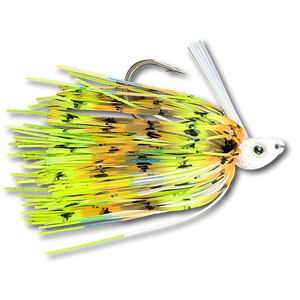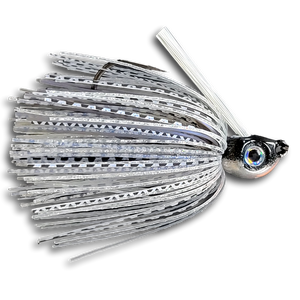Swim jigs are designed for motion. Unlike other jigs that are primarily fished along the bottom, swim jigs are meant to be retrieved through the water column, imitating baitfish, shad, or bluegill. Their streamlined head shape and light weed guards allow them to move effortlessly through vegetation, cover, or open water.
The lifelike skirt and choice of trailer add action and realism, making swim jigs highly effective in clear water, pressured conditions, and environments where fish are actively feeding.
Swim jigs are versatile and can be fished in multiple ways, depending on the conditions and target species:
Steady Retrieve: The most common way to fish a swim jig is with a steady retrieve. Cast it out, let it sink to your desired depth, and reel it in at a consistent pace. This method is ideal for mimicking baitfish in open water or along vegetation lines.
Pumping Action: Add subtle rod twitches or pauses during the retrieve to make the jig dart or flutter. This erratic movement mimics a fleeing baitfish and can trigger reaction strikes.
Skipping: Swim jigs are excellent for skipping under docks, overhanging trees, or tight spaces where fish hide. The streamlined design allows for accurate placement, and the skirt and trailer add enticing movement as it glides through the water.
Slow Rolling: Retrieve the jig slowly near the bottom to mimic a baitfish or bluegill feeding along the substrate. This is particularly effective in colder water or when fish are less aggressive.
Weed Line Drifting: Swim the jig along grass lines or over submerged vegetation, letting it glide just above the cover. Pairing the jig with a swimbait trailer enhances this presentation by adding a natural swimming motion.
Swim jigs are effective in a wide range of conditions and environments, making them one of the most versatile jigs in an angler’s tackle box:
- Spring: Swim jigs excel during the pre-spawn and spawn when fish are moving into shallow areas. Work them along grass edges, reeds, or shallow flats where bass are staging or guarding beds.
- Summer: Use swim jigs to cover water quickly, targeting bass holding near grass lines, over submerged vegetation, or along deeper ledges.
- Fall: As baitfish move into shallow water, swim jigs mimic shad, bluegill, or minnows perfectly. Cast along riprap, shallow flats, or transition zones to capitalize on active feeding.
- Winter: While less common in colder months, swim jigs can still be effective when fished slowly near deeper grass edges or rocky points.
Swim jigs shine in lakes, reservoirs, rivers, and ponds, particularly in areas with vegetation, submerged cover, or baitfish activity.
Best Colors and Trailers for Swim Jigs
Choosing the right color and trailer for your swim jig is critical for matching the forage and conditions:
- Clear Water: Natural colors like white, silver, and green pumpkin closely mimic baitfish or bluegill.
- Stained or Murky Water: Brighter or high-contrast colors like chartreuse, black and blue, or junebug improve visibility.
- Low-Light Conditions: Darker colors like black or purple create a strong silhouette.
Pair your swim jig with the right trailer to enhance its action and appeal:
- Swimbait Trailers: The most popular choice, these add a natural swimming motion that mimics baitfish.
- Craw Trailers: Perfect for adding bulk and a more subtle action, especially in cooler water or around heavy cover.
- Grub Trailers: Provide a fluttering action that works well in clear water or when fish are finicky.
- Paddle Tail Trailers: Add extra vibration and movement, making them ideal for murky water or aggressive fish.
Why Swim Jigs Are So Effective
Swim jigs are incredibly effective because of their lifelike action and versatility. Their streamlined design allows them to move through a variety of environments, from dense vegetation to open water, while their skirts and trailers mimic the natural movement of prey.
Swim jigs also excel at covering water quickly, making them a valuable tool for locating active fish. Whether fished fast or slow, their ability to adapt to changing conditions and environments makes them a go-to choice for anglers of all skill levels.
Tips for Fishing Swim Jigs
- Match the Hatch: Choose colors and trailers that closely resemble the forage fish in your fishing area for the best results.
- Adjust Retrieve Speed: Experiment with different retrieve speeds to match the mood of the fish. Faster retrieves work well in warm water, while slower retrieves are better in cold or tough conditions.
- Use the Right Gear: Pair your swim jig with a medium-heavy rod and braided or fluorocarbon line (12–20 lb test) for strength and sensitivity.
- Focus on Key Areas: Target grass edges, laydowns, docks, or riprap where fish are likely to ambush prey.
Swim jigs are a must-have for anglers looking to cover water quickly and effectively. Their lifelike action, versatility, and ability to adapt to different environments make them one of the most reliable tools for targeting bass and other predatory fish. Whether you’re working grass lines, skipping under docks, or swimming through open water, swim jigs are built to deliver results. Stock up on your favorite colors and trailers, and let these dynamic jigs take your fishing game to the next level.
Qwik Catches!















